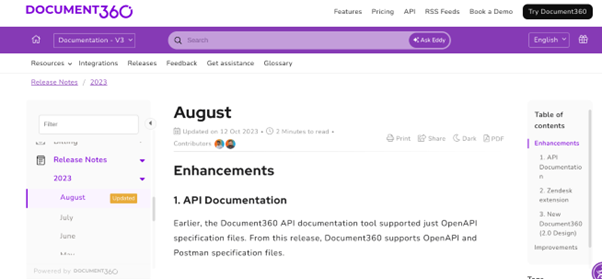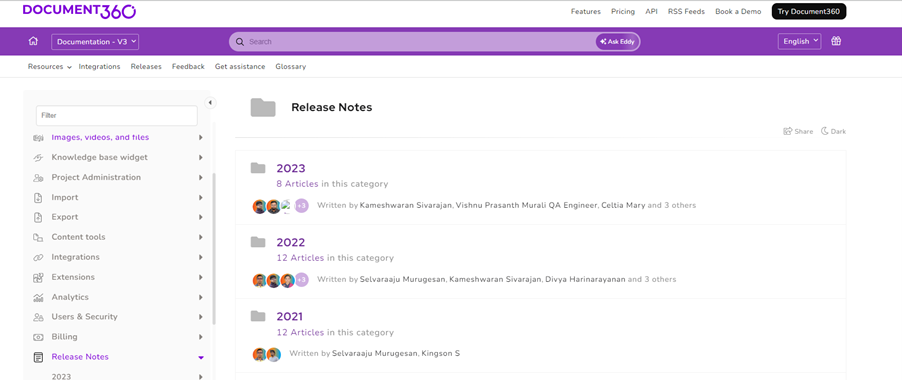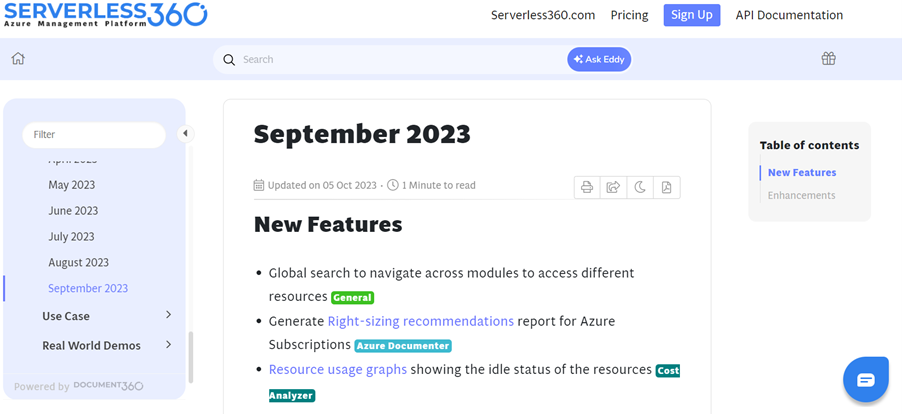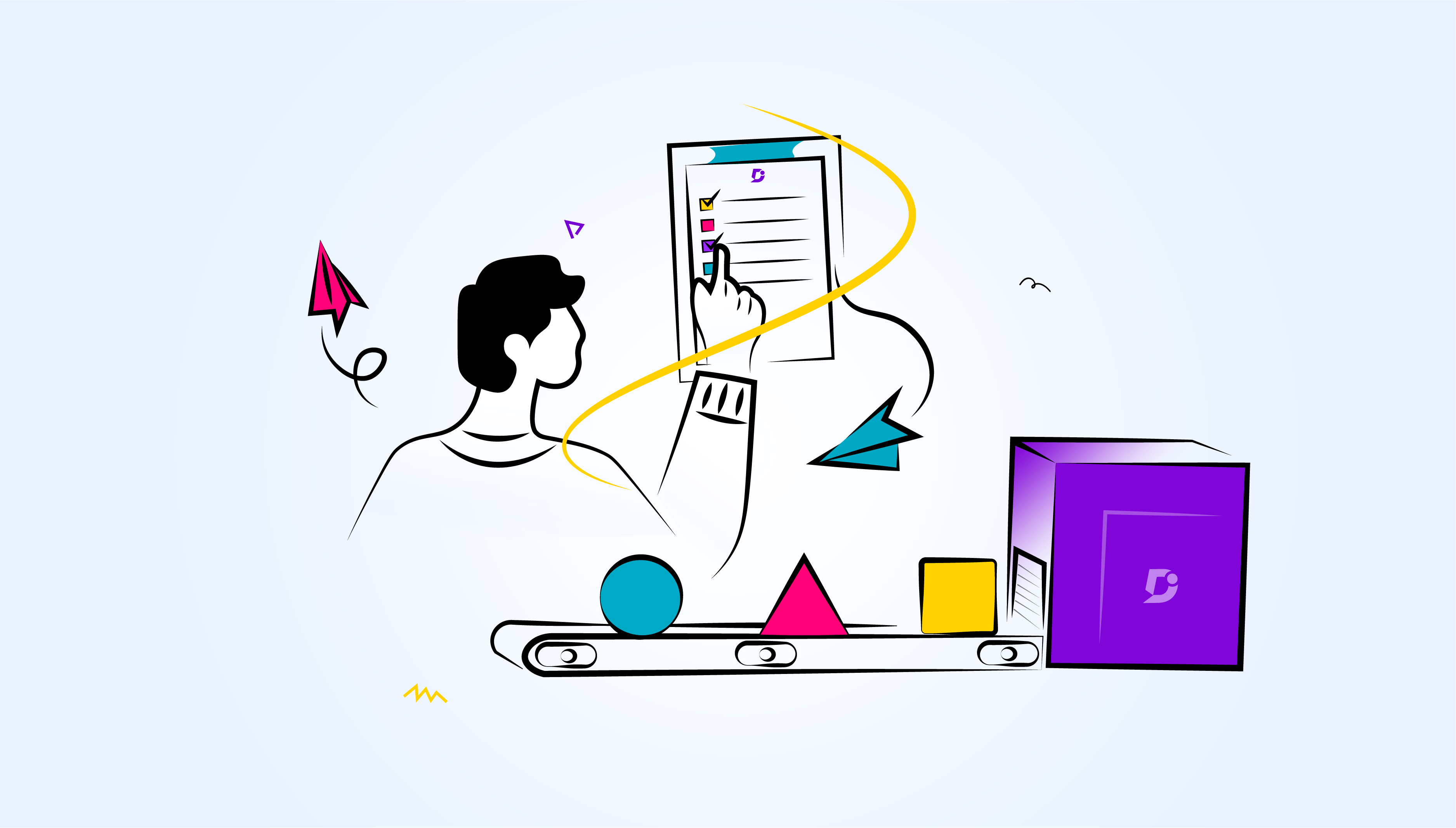Communication with customers is of the utmost importance and development teams shouldn’t just leave this task to marketing and sales. Even the development team should reach customers through documentation.
Software products need documentation to reach their full potential, but did you know there is one specific type of documentation that can simultaneously enhance your product, increase adoption, and help customers at the same time>
Of course, we’re talking about release notes or, as they might otherwise be known, the change log.
What are Release Notes?

When a product is being continuously updated like SaaS, you need a way of letting customers know what has changed. Of course, they could just log into your product and find out for themselves but another way of doing it is to publish release notes. You can use special release notes software to publish your documentation or simply add them to your website.
Release notes usually contain the name of the software update and a description of its effects along with other important information, but we’ll be talking more about what to include in your release notes later.
You would typically let customers know which system version the update applies to, any new features, and whether they need to upgrade.
All in all, release notes are a great way to communicate the value of your product to customers and show them you are continuously developing it.
Importance of Release Notes in Software Development
We’re going to look at the importance of release notes in more detail.
Communication with Users
Release notes are an important way of communicating with users because they show exactly how the software system has changed. Customers may get a bit of a shock if they log into your software and find their favorite feature has been changed or removed. Release notes allow you to communicate how and why changes have happened.
Documentation and Historical Record
Updating your product is great but you need to record it as documentation to ensure everyone knows how the product has changed. For example, potential buyers of your software will be able to view the historical record to see how your product has evolved and understand that it’s under continuous improvement, showing that your team strives to meet the needs of its users.
User Adoption and Engagement
If you want to drive the adoption of a new feature, you need to make sure your users know about it. You keep users engaged if they know about new features and actively publish content that explains and promotes any changes. If users know why a particular feature can benefit them, they are more likely to adopt it and be retained with your product.
Feedback and Iterative Development
When you publish your release notes, you can solicit feedback from users about how they feel about the changes. Establishing an open dialogue brings your product closer to customers and allows you to engage in iterative development rather than risking future releases that damage your market share.
Transparency and Trust
Of course, with SaaS, product updates can be automatically rolled out without informing customers, but release notes help create transparency and trust. This is particularly important if you are phasing out a feature for some reason and reduces the likelihood of churn.
Support and Troubleshooting
In case there are bugs in your new release you have yet to fix, release notes can help with support and troubleshooting known issues, reducing the load on your customer support team. Customers understand that you are aware of any issues and are working to fix them instead of feeling that you are developing a shoddy product.
Collaboration within Development Teams
Development teams can collaborate with other departments, such as product and technical writers when it comes to publishing release notes. Release notes are beneficial for all of these teams since they are aimed at customers adopting the new features, which all parties have a stake in.
Legal and Compliance Requirements
While release notes are not mandatory, they can be important for legal and compliance requirements when updating your software for expanded use cases. Customers need to be assured of any risks inherent in using the new version of your software.
Components of Effective Release Notes
Now, we’ll take a look at everything you need to include ineffective release notes.
Version Information
Include the particular version your release applies to so users know whether the release note applies to them.
Release Date
For reference purposes, include the release date so users know when the release was made.
Clear and Concise Summary
To avoid users having to scroll through walls of text, include a clear and concise summary of the updates.
Detailed Change Log
Here, you can go into some more depth about the changelog, including how and why the changes were made, including any important technical details.
Writing Style and Tone
Although release notes are a formal document, you might still want to use a friendly style and tone to communicate your updates.
User Impact and Benefits
Users don’t always like change, so that’s why it’s helpful to include the user impact and benefits to explain why you made the updates. Focus on how the new updates will improve their lives and provide more value for money.
Links to Documentation and Support
You might have more extensive user guides and documentation you can link to, especially for complex changes that require more explanation, so be sure to include them, as well as the ability to contact your support team.
Visuals (Optional)
Including screenshots or other visuals can be a great way to bring your release notes to life and communicate changes to users, especially when demonstrating how to use a new feature.
Known Issues
Sometimes, you might have to release an update with known issues, in which case it’s best to inform your users for transparency in case they run into problems. Let them know you are working to fix them.
Feedback Mechanism
Provide a feedback mechanism such as a link to your email or community forum where users can express their opinions. Release notes should be part of an ongoing dialog where you take the feedback of your users seriously.
Prioritizing Information
Put the most important information first so your users have a chance to absorb it before they get bored! You can always link to more information later in case you have more to say but don’t want to overwhelm your users in the release notes.
Schedule a demo with one of our experts to take a deeper dive into Document360
Book A Demo
Writing Style and Tone of Release Notes
Aside from the basic information that you need to include in your release notes, you should be aiming for a particular style and tone in your documentation.
Audience-Centric Approach
Remember, it’s all about the user, so adopt an audience-centric approach when writing your release notes. This means focusing on the impact on the user, using language they will understand, and showing an appreciation of their perspective.
Clarity and Simplicity
Above all, keep it simple and clear. Users aren’t here to read a thesis concerning your software product but rather to access the necessary information in a straightforward manner. Remove unnecessary words and explanations in favor of brevity.
Positive and Encouraging Tone
Change is hard, and you should strive for a positive and encouraging tone when writing your release notes, emphasizing why the change is necessary and important. Embrace all your users and help them to adopt your new features.
Avoid Negative Language
On the other side of the coin, avoid negative language that makes your users feel discouraged. Don’t say anything like, “Unfortunately, we have had to discontinue this feature” as that makes users feel like they are missing out on something. Instead, you could try “We are taking our product in the following direction.”
Consistency
Reading release notes can be a bit of a chore, so make sure to maintain consistency in your documentation every time you publish a new update. When users know what to expect, including an easy-to-understand format, they are more likely to engage with your notes.
User-Centered Language
Make sure to use the language of your users when writing release notes to ensure they understand your explanation. If you refer to your feature internally as a “widget” but users know it as an “assistant”, you might create confusion if you don’t match users’ expectations.
Engagement and Excitement
Remember, release notes are not simply a dry document but an opportunity to get excited about new updates! Convey your excitement to your users and get them enthusiastic about trying new features and accomplishing more with the same product. Release notes showcase great value for money for your users.
User Benefits
Similarly, talking about the benefits of the new release creates a positive impression on your users. It’s unlikely you would change the product if they didn’t have a beneficial impact so communicate this when talking about your updates.
Avoid Over-Technical Details
For most audiences, overly technical details will be distracting and unnecessary. You know your users best and have a grasp of their technical proficiency, so try not to get bogged down in the details when explaining your updates. If you must use technical terms, consider whether to explain what they mean.
Transparency
The worst thing you can do is mislead your users in release notes. Be honest about changes that have been made, even if you fear negative feedback. By being upfront and transparent, users will be more likely to trust you and believe you are acting in their best interests.
Encouraging User Feedback
Even though user feedback isn’t always positive, you should encourage it in your release notes because documentation is part of a conversation. Including an email link or similar is a great opportunity to gather feedback about your new release and hear what users really think of the product.
3 Great Examples of Release Notes
Now, we’re going to look at five companies leading the way in the realm of release notes.
1. Document360

Document360 is a popular documentation and knowledge-based platform that helps organizations create, manage, and publish documentation effectively. To keep its users informed and to highlight continuous improvements and new features, Document360 regularly updates release notes. These release notes serve as a valuable resource for users, administrators, and developers, providing detailed information about updates, enhancements, bug fixes, and new functionalities.
2. Blackthorn

Blackthorn is a software product or application that is actively developed and maintained. To keep users, administrators, and stakeholders informed about the latest updates, enhancements, and bug fixes, the development team regularly publishes release notes. These release notes are essential in providing transparency, demonstrating the commitment to improvement, and ensuring users are aware of changes that may affect their usage of the software.
3. Serverless360

Serverless360 is a comprehensive platform for managing and monitoring serverless applications, such as those built on Microsoft Azure Functions, Logic Apps, and Service Bus. To keep its user base informed about the latest updates, feature enhancements, and bug fixes, the Serverless360 development team regularly publishes release notes. These release notes are crucial in providing transparency, demonstrating a commitment to improvement, and ensuring that users are aware of changes that might impact their use of the platform.
Challenges and Solutions in Release Notes
You may encounter some challenges when writing your release notes so now we present some solutions to common hurdles.
Balancing Detail with Brevity
Give your users as much detail as they need while keeping it short and simple. This could be achieved by breaking your release notes down and allowing users to skip to the features or updates that interest them.
Managing Expectations
New releases are exciting but make sure not to build up your users’ hopes too much. Let them know what they can achieve and whether they will need to upgrade to a higher plan to access benefits.
Handling Negative Feedback
Be graceful and appreciative even when you receive negative feedback. Release notes may stir up controversy as not everyone may like the changes you have made. Accept that being popular with some comes with the territory of continually evolving your product.
Communicating Technical Changes
Technical changes underpinning your software updates must be communicated clearly, especially if your product relies on APIs and similar functions. If your audience is developers, clearly communicate the new requirements and share specifications to avoid disrupting development activities.
Ensuring Accessibility
Your release notes should be accessible to everyone, including those with slow internet connections or impaired visibility. If you include images and videos, make sure the same information is also accessible through text.
Timely Release Notes
Don’t wait until weeks or months have passed before publishing your release notes. Try to time their publication with your software’s new release or you’ll leave your users confused and disappointed. If your release notes are late, acknowledge your tardiness and try to speed up in the future by prioritizing publication alongside releases.
Maintaining Consistency
Especially with more complex release notes, maintaining consistency is key. If users know what to expect, they will be more likely to engage and find out more about new updates. The best outcome you can hope for is when users look out for your quarterly updates in their inbox. Using a template is key when you have multiple contributors to your release notes.
Handling Complex Changes
When you have complex changes to communicate you can break them down into smaller chunks. Individually address each feature and issue you have tackled to ensure users don’t get overwhelmed.
Getting User Feedback
Users may not always be motivated to provide feedback but you can encourage more by acknowledging when feedback has spurred on new features and improvements. This shows you value user feedback and take it on board for your product roadmap.
Archiving and Cataloging Release Notes
Being able to look back at past release notes is important for prospective customers who want to see how your product has developed. Build an archive to show off the development process and catalog your release notes.
Conclusion
If you’ve made changes to your software product, it’s time to celebrate! Make sure you mark the new release with your customers through release notes so they know they’re getting value and you’re listening to their feedback.
There’s a right and wrong way to write release notes, but one thing’s for sure: they’re an indispensable part of your product documentation. Make sure everyone, from development to product to technical writers, knows how important they are.
Establishing an ongoing dialog with your users where you explain changes and they can submit feedback is crucial in driving product adoption and customer loyalty.




 –
– 

